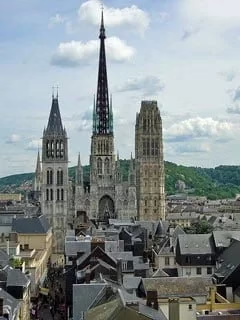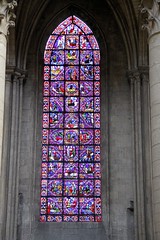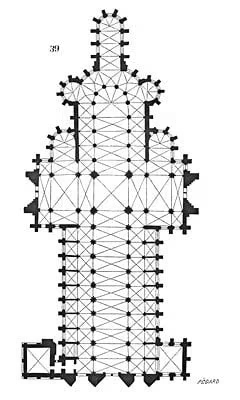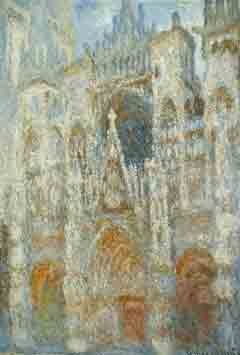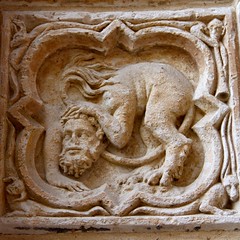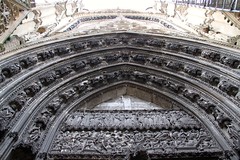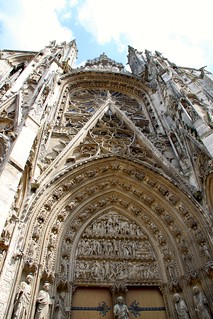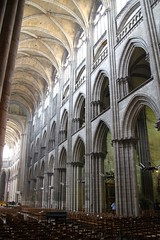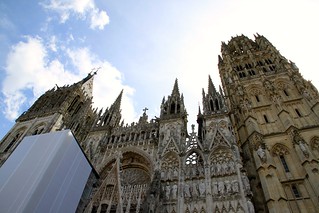The magnificent Gothic Rouen Cathedral has the tallest church spire in France and a wealth of art, history, and architectural details.
Rouen Cathedral (La cathédrale primatiale Notre-Dame de l’Assomption de Rouen) is one of the most impressive Gothic churches ever built. Construction dragged on for three centuries allowing all forms of the Gothic spectrum from early to high, flamboyant, and late to feature in the main structures. The spire is even Neo-Gothic – added in the 19th century, it is the tallest church tower in France. The dukes of Normandy were traditionally crowned here and several are buried in the cathedral, including the heart of Richard the Lion Heart. Joan of Arc was put on trial in the bishops’ palace. The church has some stained-glass windows from the early-13th century and the oldest recumbent tomb statue in France.
The Building of Rouen Cathedral
Rouen Cathedral is built on a site that has been used for Christian worship since at least the early 4th century. Most of the present church was constructed between 1200 and the early 16th century.
Construction of the current church started during the late-12th century to modernize and enlarge a Romanesque cathedral. A fire during Easter 1200 caused major damage to the structure allowing the new Gothic church to be built freer from the constraints of the Romanesque predecessor.
Construction of the Gothic cathedral resumed shortly afterward but the Hundred Years War, revolts, finances, fire, and weather interfered with the building project, which dragged on for three centuries. (Parts of the church were always in use.) The long building period allowed for elements from the full Gothic spectrum – early, high, flamboyant, and late (plus a touch of neo in the 19th century).
Rouen Cathedral was damaged but not destroyed during amongst others the Wars of Religion, the French Revolution, and the Second World War. As with any old house, maintenance work never ends and part of the cathedral is always covered by protective sheeting and scaffolding.
Many of the windows were blown out in 1944 during the Second World War. However, in 1939, on the initiative of Jean Lafond, almost all stained-glass windows in Rouen were removed from churches and historic buildings and kept safely until the end of the war. Rouen Cathedral thus has stained-glass windows dating from as far back as 1210.
Dimensions and Floor Plan of Rouen Cathedral
Rouen Cathedral is not the largest cathedral in France but it has the tallest steeple, the widest western façade, and the rest of the dimensions are impressive too. (North is to the left on the shown floor plan.)
Exterior Measurements:
- Total length – 144 m
- Width of the western façade – 61.6 m
- Height of the steeple – 151 m (since 1876)
- Tour St Romain – 82 m
- Tour de Beurre – 75 m
Interior Measurements:
- Total length – 137 m
- Length of the nave – 60 m
- Height of the nave – 28 m
- Width of the nave including two side aisles – 24.2 m
- Width of the central aisle – 11.3 m
- Height of side aisles – 14 m
- Height of the lantern tower – 51 m
- Length of the choir – 34.30 m
- Width of the choir – 12.7 m
- Interior length of the transept – 54 m
See also the floor plan (description in French only).
Western Façade – a Monet Favorite
The western façade of Rouen Cathedral is the largest of any church in France. It was famously painted by Impressionist artist Claude Monet in a series of 28 paintings showing the façade at different times of the day. The paintings are now spread over the world with one in the local Fine Art Museum, five in the Musée d’Orsay, but all can be seen together, ordered by time of day, online on the Rouen parish website (French only) or on Wikipedia.
→ See also Claude Monet Paintings in Museums in Paris for the world’s best collections of top artworks by Monet and other Impressionist artists.
The oldest parts of the Gothic cathedral are the left tower and the two side portals on the Western façade – these date from the 12th century. The tympana are from the 13th century – the one on the left above the Portail St Jean shows the death of John the Baptist and on the Portail St Etienne the stoning of St Stephan (the first Christian martyr). The latticework window gallery and gables are Flamboyant Gothic from the late 14 th, early 15th centuries.
The Early Gothic Tour St-Romain, the tower on the left (north), is the older with its base dating from the 12thcentury. Its construction is generally seen as the start of the Gothic cathedral building project. The roof with golden suns, which was only added in the 15th century, burned down in 1944 after a bombing raid by the US Air Force but was restored true to the original.
In 1507, the grander Flamboyant Gothic south tower was the last major part of the church to have been completed. It carries an octagonal crown and never had a steeple. It is known as the Tour de Beurre (Butter Tower), as it was believed that the construction was financed through indulgences paid by some of the rich, who did not give up eating butter during lent. (The magnificent Gothic cathedral in Bourges, France Centre, has a similar Butter Tower.)
The central doorway was only completed in the 16th century, as the construction of the Butter Tower damaged the older structure. The tympanum here has the Tree of Jesse. It was destroyed by the Huguenots during the Wars of Religion but replaced in the early 17th century and recently restored. The row of apostles are copies – the surviving statues can be seen close up in the ambulatory of the church (until they are moved eventually to a museum).
The Booksellers’ Portal
Rouen Cathedral’s transept can be entered from the north through the Portail des Libraries (Booksellers Portal). It is reached via a Flamboyant Gothic stone gateway and the Cours des Libraries, a courtyard traditionally used by booksellers. Note here the reliefs with scenes from the creation and early Genesis, as well as some fantasy animals, many combining body parts from humans.
The late 13th-century tympanum is of the Last Judgment – a scene often used at the central doorway of Gothic churches. The tympanum is due for a cleanup but the dead rising from the graves in the lower panel and being judged in the upper level are still easy to decipher. To the right, one of the sinners in a boiling cauldron is a bishop and next to it the devil grabs a sinner still clutching his bag of money.
Adjacent to the courtyard is the Bishop’s Palace (Archevêché) where Joan of Arc (Jeanne d’Arc) was tried and convicted in 1431. A plaque here reminds that she was rehabilitated in 1456, after Charles VII retook Rouen from the English. A chapel in the cathedral is dedicated to Joan of Arc but a large 20 th-century church at the other end of the old town is the main shrine to Jeanne d’Arc, who became the patron saint of France in 1920.
Southern Portal and Steeple of Rouen Cathedral
The southern doorway (Portail de la Calende) is from the 14th century while the two towers on its side are a century older. The tympanum showing the passion and resurrection of Christ is considered one of the finest works from this period.
The south side of the cathedral affords some excellent views of the church towers too. The spire on the central lantern tower is at 151 m (496 ft) the tallest in France and the fourth tallest Christian church in the world.
The original square-base lantern tower from the 13th century was raised in the 16th century and capped by a wooden spire covered in lead. Although lightning struck the cathedral often, the spire brought down by a lightning bolt in 1822 stood for almost 300 years.
The current cast-iron spire of Rouen Cathedral was completed in 1876 and was for four years the tallest man-made structure in the world. The steeple is missing one of the four small green turrets – it fell through the roof during a storm on December 26, 1999. The damage can still be seen in the repaired vaults inside the choir – look up when standing near Rollo and Richard the Lion Heart’s tombs.
The Interior of Rouen Cathedral
The interior of Rouen Cathedral is High Gothic at its best. The nave soars four stories high and the church seems to stretch on forever. The Rouen Cathedral is third in length in France after the huge Reims and Amiens cathedrals.
The Nave of Rouen Cathedral
The 11-bay nave is early Gothic but many of the chapels and decorations were added in high Gothic. The well-lit nave is 28 m high with many of the clerestory windows clear. The two side aisles are half the height of the central aisle and lined with chapels.
Note the stained-glass windows in the chapels of St Sever and St Jean (north side). The upper sections are from 1210, the oldest in the cathedral, while the lower sections are 15th century. The rose window in the west above the modern organ is Flamboyant Gothic.
Transept and the Lantern Tower
At the north end of the transept is the Escalier de la Librarie (Booksellers’ Stairway) – the lower flight is from the 15th century while the upper flight was added in the 18th century.
The lantern tower at the crossing rises 51 m (167 ft). One of the four huge pillars keeping the tower up was almost destroyed by an RAF bomb in 1944; its collapse could have brought the whole church down.
Of the south end is the Joan of Arc Chapel with modern glass – a large church in the opposite end of the old town is dedicated to France’s patron saint. The rest of the windows in the south transept is mostly from the Renaissance and tells the martyrdom of St Romain.
Choir and Ambulatory of Rouen Cathedral
The choir is 13th century and shows how well Gothic architecture, compared to the earlier Romanesque, can give an impression of lightness and elegance while still keeping up the heavy vaulted roof.
In the ambulatory are several tombs with recumbent figures of Norman dukes. The statue of Rollo (c. 846 to c. 931 and first Viking duke of Normandy) is a copy and only his femur (thigh bone) is left in the tomb.
Only the heart of Richard the Lion Heart (1157-1199), king of England and 12th duke of Normandy, is entombed here. His entrails are buried at Chalus-Chabrol where he died, while the rest of his body is buried at Fontevraud Abbey (near Tours on the Loire). At his feet lies a lion – not only a reference to his nickname but also a medieval symbol of resurrection.
Also in this area are the original statues of the prophets taken from the central doorway on the western façade – they will eventually be moved to a museum. Five of the stained-glass windows are from the 13th century, many featuring strong Chartres blue and red pieces. The rest of the stained glass is mostly from the Renaissance.
The 14th-century Lady’s (or Virgin’s) Chapel is 25 m long and usually not open to tourists. Most of the glass dates from the building period but much of the other decorations are two hundred years newer. On the left wall of the chapel is the tomb of Louis de Brézé. He was the seneschal of Normandy but is now better known for being the husband of Diane de Poitiers – she became the favorite mistress of Henri II after her husband’s death. (See Chenonceau for more on Diane, Henry, and Catherine de Medici – Henry’s formidable wife).
To the left of the chapel is the grave of Hugues d’Amiens (died 1164), Bishop of Rouen. His body was placed in a tomb from the 12th century and is believed to have the oldest recumbent tomb statue (gisant) in France.
The Romanesque crypt was part of the 11th-century Romanesque cathedral destroyed by fire in 1200. It can only be seen on the guided tour of the cathedral.
Opening Hours of Rouen Cathedral
Rouen Cathedral is still a working Roman Catholic church and thus has fairly long opening hours and free admission. Note the closure on Monday mornings and also lunch hour closings during the colder months.
Rouen Cathedral’s opening hours are:
- Monday 2 to 6 pm
- Tuesday to Saturday – 9 am to 7 pm
- Sunday 8 am to 6 pm
From November to April, the church closes at 6 pm and is closed over lunch from noon to 2 pm.
Parts of the church – usually the choir area or Virgin’s Chapel – are closed during services. Sometimes one of the ambulatory entrances remains open.
In summer, late June to mid-September, a free light show is projected onto the western façade – usually showing Monet-like colors and Impressionist dots. As it grows dark late in summer, the half-hour show starts after 10 pm.
Rouen Cathedral is in a part of France with many large churches – only a few blocks away is the Church of St Ouen, another Gothic wonder even larger than the cathedral. A short drive to the west of Rouen are the Romanesque churches of St Martin de Boscherville and the marvelous ruins at Jumièges. The largest Gothic church in France is not far away either in Amiens.
For more on Rouen Cathedral see also:
- Photos of Rouen Cathedral on Flickr.
- Parish of Notre Dame de Rouen – a full description of the church in French including photos of the parts of the cathedral generally not seen by visitors.
- Various parts of the cathedral seen in 360° photos.

